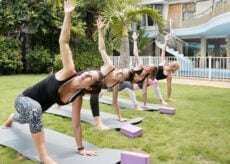1 Long Workout vs Multiple Micro-Workouts: Which is Better?

In this modern world, it’s difficult to find time for anything, and this shortage of time can lead us to skip activities we may deem less important than others. Unfortunately, sometimes the activities we need the most, like exercise for example, can get pushed aside as something that is “optional.” Yet the numerous benefits of exercise are unquestioned, leading some experts to suggest short workouts spread out throughout the day, known as micro-workouts.
On the other hand, there is a contingent of folks who feel they must spend long periods of time in the gym to accomplish anything of substance. They wouldn’t dream of splitting their workouts into micro-workouts throughout the day or week and insist on several longer training sessions to completely tax the muscles and cardiovascular system. So, is one long workout better than multiple micro-workouts?
According to the Physical Activity Guidelines for Americans, adults should strive to get between 150 and 300 minutes of moderate cardiovascular exercise each week, coupled with at least two days of resistance training. So, which camp is correct when it comes to one long workout vs. multiple micro-workouts? Well, the answer is… wait for it… both.
What are the Benefits of a Long Workout?
Any exercise is good exercise, but some folks feel like they can’t get anything real accomplished unless they spend copious amounts of time in the gym. There are other benefits to extended exercise sessions as well. You may be interested in longer workouts for a variety of reasons.
1. Stress relief—getting in a long workout may be just what you need to sweat away the day’s stress and clear your mind of thoughts that may be swirling around in your head. If you’ve ever heard someone say they’re going to “take it out on the weights at the gym,” they most likely had a hard day and are ready to wear themselves out with a tough workout. A workout like this can leave you feeling depleted and exhausted while significantly helping you reduce the effects of stress you were feeling prior to your workout.
2. Building muscle—if your goal is to build muscle (and it should be one of your fitness goals) then you will benefit from working your various muscle groups for longer periods of time (maybe 30 minutes or more) several times a week. It’s not that a quick workout here and there won’t be beneficial, but when you’re on a resistance training program, there are specific protocols to follow which will help you maximize your time in the gym with the most muscle building possible. Using strategies like progressive resistance training, drop sets, high-repetition workouts, and more do require a certain time investment and are not well suited to micro-workouts.
3. Burning fat—again, not that you “can’t” burn fat doing multiple small workouts throughout the day, but many folks could benefit from a more lengthy workout style. And, if you really want to burn fat, a workout that begins and ends with steady state cardio and includes some high interval training sessions in the middle can be a physiological prescription for success. Once again, this type of workout is not something that can be accomplished in small spurts during your day. Rather, to be most effective, it should be performed in succession. The longer your cardio session overall, the more calories you are burning.
4. Reduce depression—yes, studies show that you can significantly reduce the side effects of depression by exercising on a regular basis. Scientists say that walking for 30 minutes a day or more helps to lift depression and improve health across the board. Studies do show that this may be a case of “more is better” when it comes to targeting these types of ailments. So, here’s another great reason to extend your workout into the 30-minute to one-hour zone.
Important note: it may also take you five to ten minutes just to warm up and get ready to exercise. No sense cutting yourself short by stopping when your body is primed for action and ready for more.
What Are the Benefits of Multiple Micro-Workouts?
In case you haven’t heard of micro-workouts, they are small, short bursts of exercise you do throughout the day. You may engage in exercise for five or ten minutes, here and there, whenever you have some time (at least three times daily). This enables you to burn off more calories than you normally would if you remained sedentary all day long.
And, it turns out that these little workout breaks can really add up over time. The more often you take a few minutes to add some exercise to your day, the better off you’ll be. In fact, the Centers for Disease Control and Prevention say that even small bouts of exercise done multiple times during the day can have you feeling better overall, sleeping better, and improving your health markers, just like longer workouts do.
These micro-workouts are sometimes referred to HIIPA (High Intensity Incidental Physical Activity) and make it easy to get your daily dose of activity.
1. Just get in your minutes—if you’re familiar with some of the more popular weight-loss apps, then you may have heard of the concept of “counting your points” or “if it fits my macros.” This is just a simplified way of loosening up the normal rigidity of a diet plan and the same concept can be applied to your workout regimen. Just think… if you did five small 10-minute workouts throughout your day, in no time at all, you would have accomplished what a 50-minute lengthy workout would.
2. Convenience—the convenience factor cannot be underestimated. Just being able to stop what you’re doing and get in a quick few minutes of exercise can make the difference between getting exercise that day and not getting exercise. Plus, the fact that you’re unlikely to need to change your clothes, drive somewhere, or shower afterwards is priceless in terms of convenience and time savings.
3. Calorie burn—the extra calories you expend by adding in a number of micro-workouts to your daily routine can really add up. This means you’ll naturally start to burn off more body fat and even raise your metabolism the more often you throw a few micro-workouts into your day.
So, Which One Is the Winner?
Exercise is exercise, and there are great advantages to both several long workouts a week and many short micro-workouts during your days. But, the answer to which style is better for you is… the one that fits your lifestyle and goals best. And when it comes to fighting off the negative effects of an overall sedentary lifestyle, what may be even better is a combination of both.
Remember, getting in exercise is critical for health and wellbeing, so no matter which route you take, it will be beneficial. And, don’t forget, you don’t have to narrow it down to just one form of exercise. In the end, mixing it up to best suit your style may be your best bet. By combining both long workouts and micro-workouts, you may find exercise overall even more enjoyable and beneficial.







